Internal and external fixation PDF
VerifiedAdded on 2021/08/19
|24
|1151
|52
AI Summary
Contribute Materials
Your contribution can guide someone’s learning journey. Share your
documents today.

INTERNAL AND EXTERNAL FIXATION
Secure Best Marks with AI Grader
Need help grading? Try our AI Grader for instant feedback on your assignments.
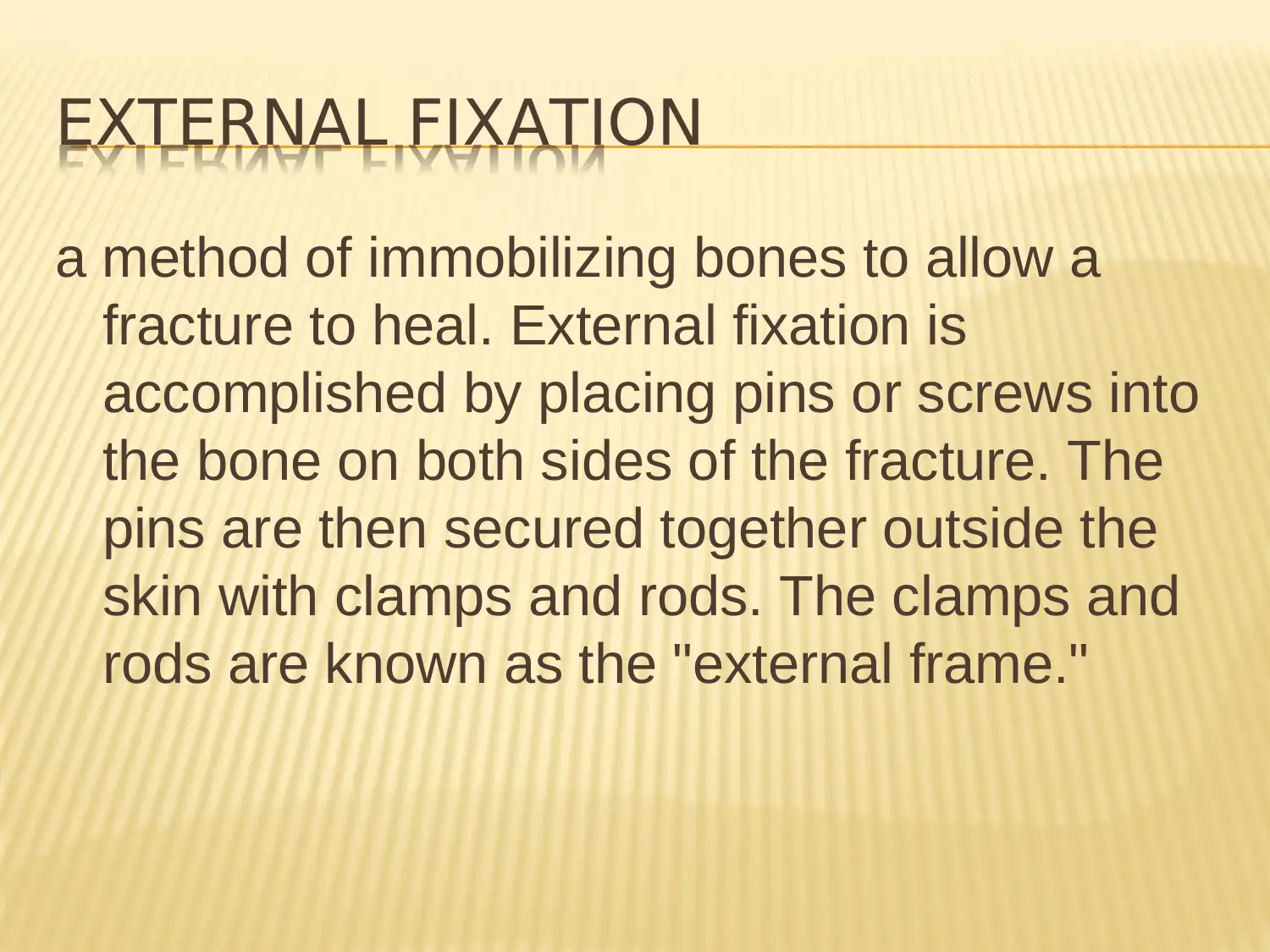
EXTERNAL FIXATION
a method of immobilizing bones to allow a
fracture to heal. External fixation is
accomplished by placing pins or screws into
the bone on both sides of the fracture. The
pins are then secured together outside the
skin with clamps and rods. The clamps and
rods are known as the "external frame."
a method of immobilizing bones to allow a
fracture to heal. External fixation is
accomplished by placing pins or screws into
the bone on both sides of the fracture. The
pins are then secured together outside the
skin with clamps and rods. The clamps and
rods are known as the "external frame."
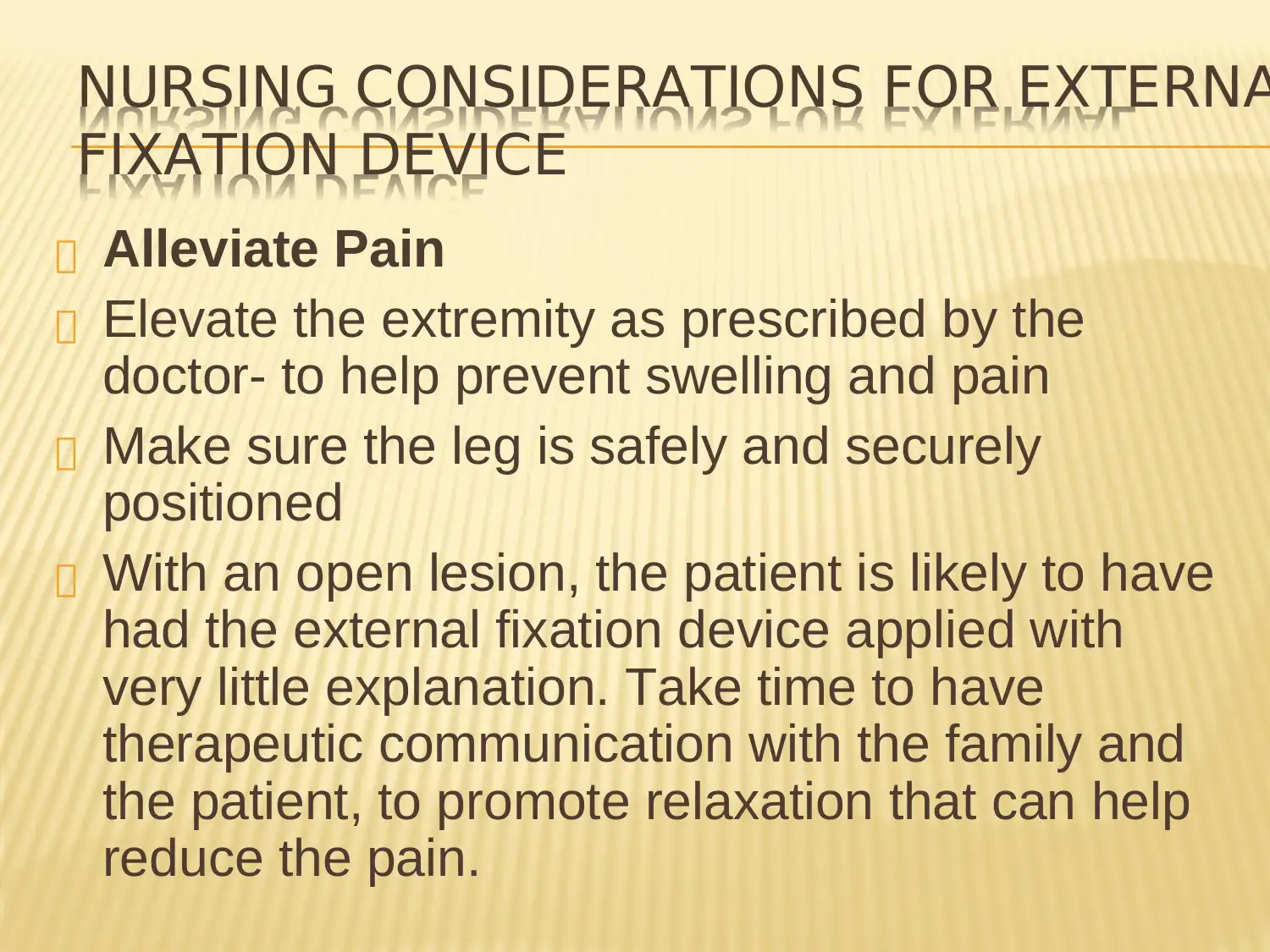
NURSING CONSIDERATIONS FOR EXTERNA
FIXATION DEVICE
Alleviate Pain
Elevate the extremity as prescribed by the
doctor- to help prevent swelling and pain
Make sure the leg is safely and securely
positioned
With an open lesion, the patient is likely to have
had the external fixation device applied with
very little explanation. Take time to have
therapeutic communication with the family and
the patient, to promote relaxation that can help
reduce the pain.
FIXATION DEVICE
Alleviate Pain
Elevate the extremity as prescribed by the
doctor- to help prevent swelling and pain
Make sure the leg is safely and securely
positioned
With an open lesion, the patient is likely to have
had the external fixation device applied with
very little explanation. Take time to have
therapeutic communication with the family and
the patient, to promote relaxation that can help
reduce the pain.
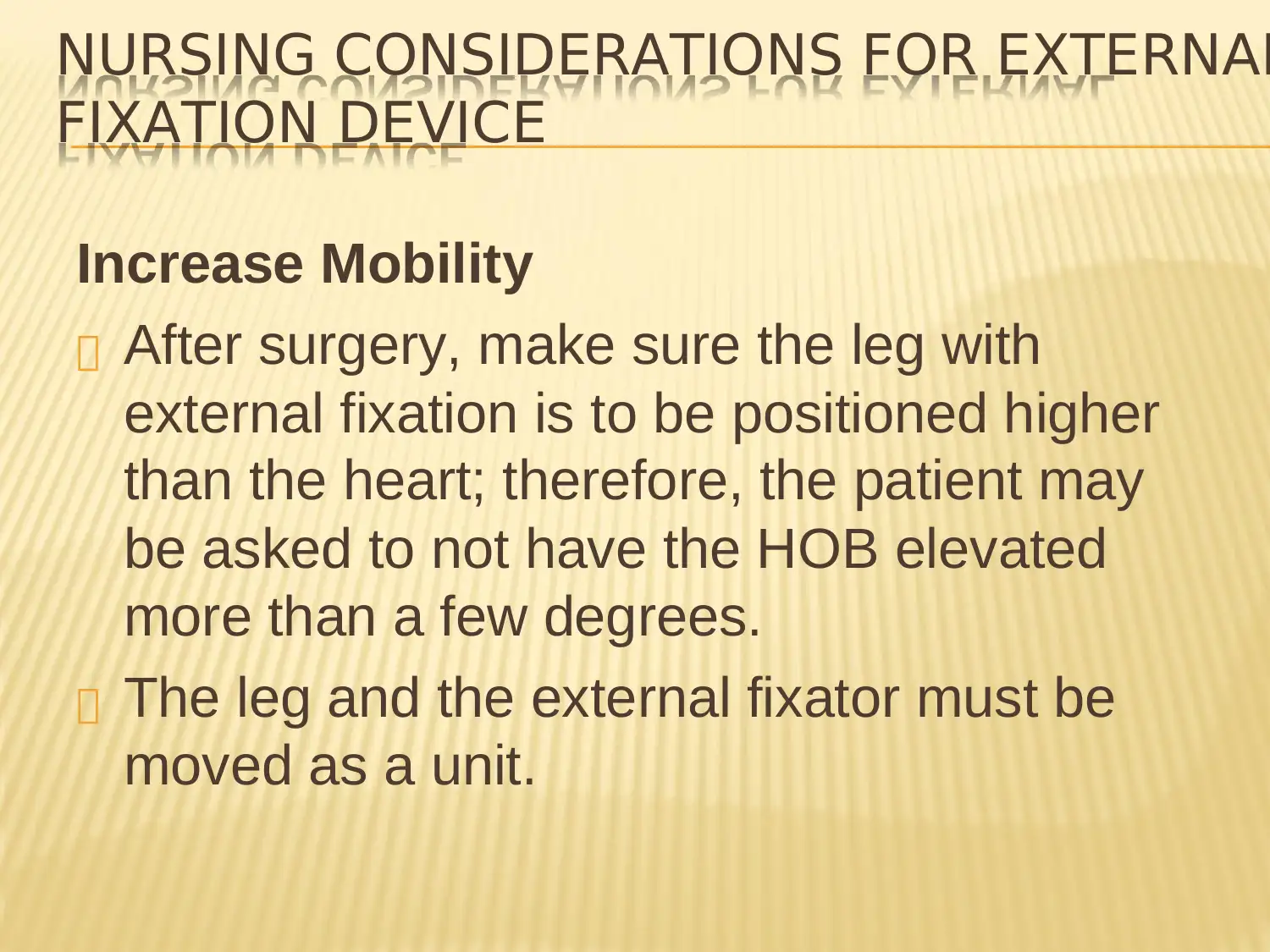
NURSING CONSIDERATIONS FOR EXTERNAL
FIXATION DEVICE
Increase Mobility
After surgery, make sure the leg with
external fixation is to be positioned higher
than the heart; therefore, the patient may
be asked to not have the HOB elevated
more than a few degrees.
The leg and the external fixator must be
moved as a unit.
FIXATION DEVICE
Increase Mobility
After surgery, make sure the leg with
external fixation is to be positioned higher
than the heart; therefore, the patient may
be asked to not have the HOB elevated
more than a few degrees.
The leg and the external fixator must be
moved as a unit.
Secure Best Marks with AI Grader
Need help grading? Try our AI Grader for instant feedback on your assignments.
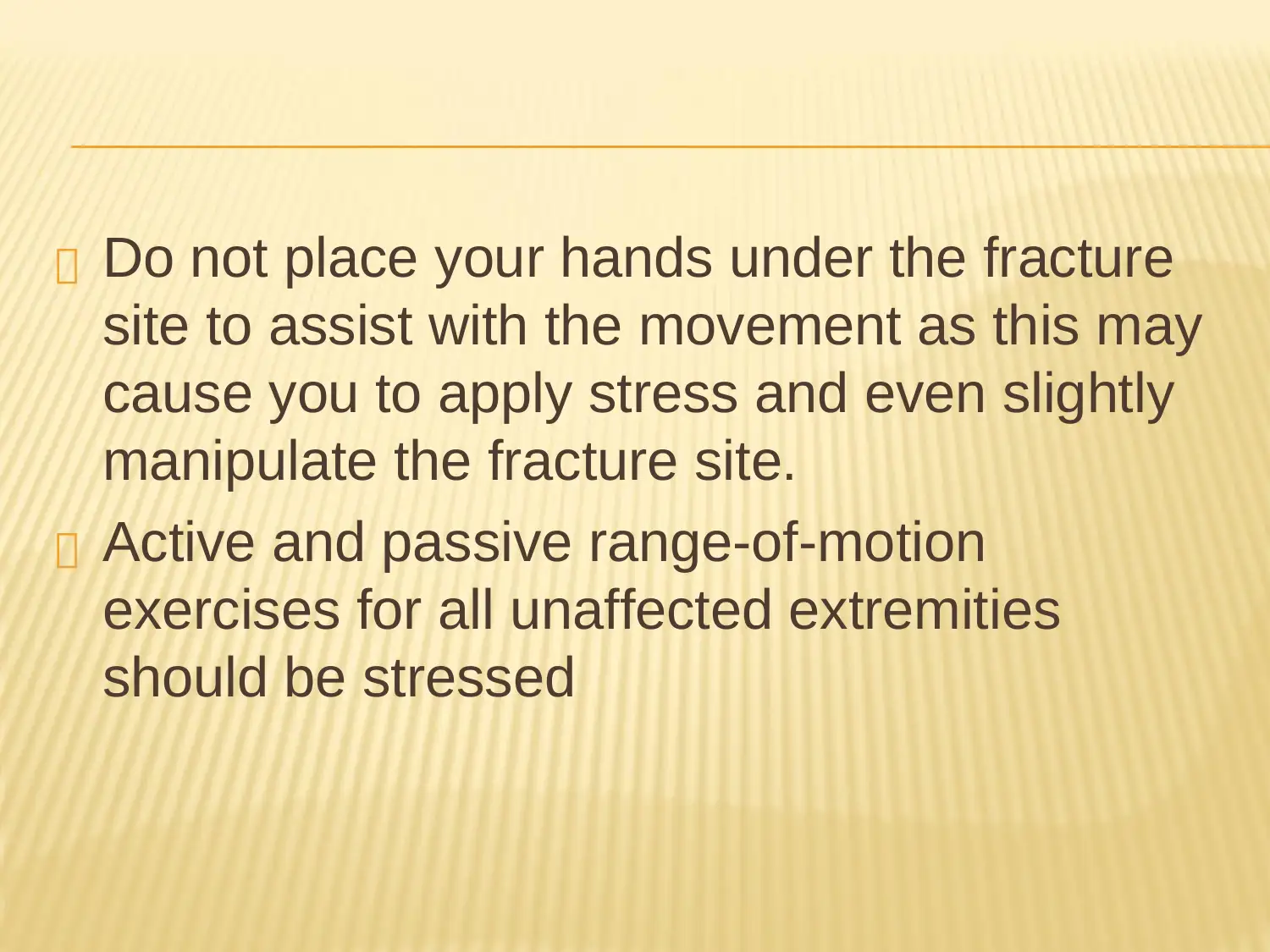
Do not place your hands under the fracture
site to assist with the movement as this may
cause you to apply stress and even slightly
manipulate the fracture site.
Active and passive range-of-motion
exercises for all unaffected extremities
should be stressed
site to assist with the movement as this may
cause you to apply stress and even slightly
manipulate the fracture site.
Active and passive range-of-motion
exercises for all unaffected extremities
should be stressed
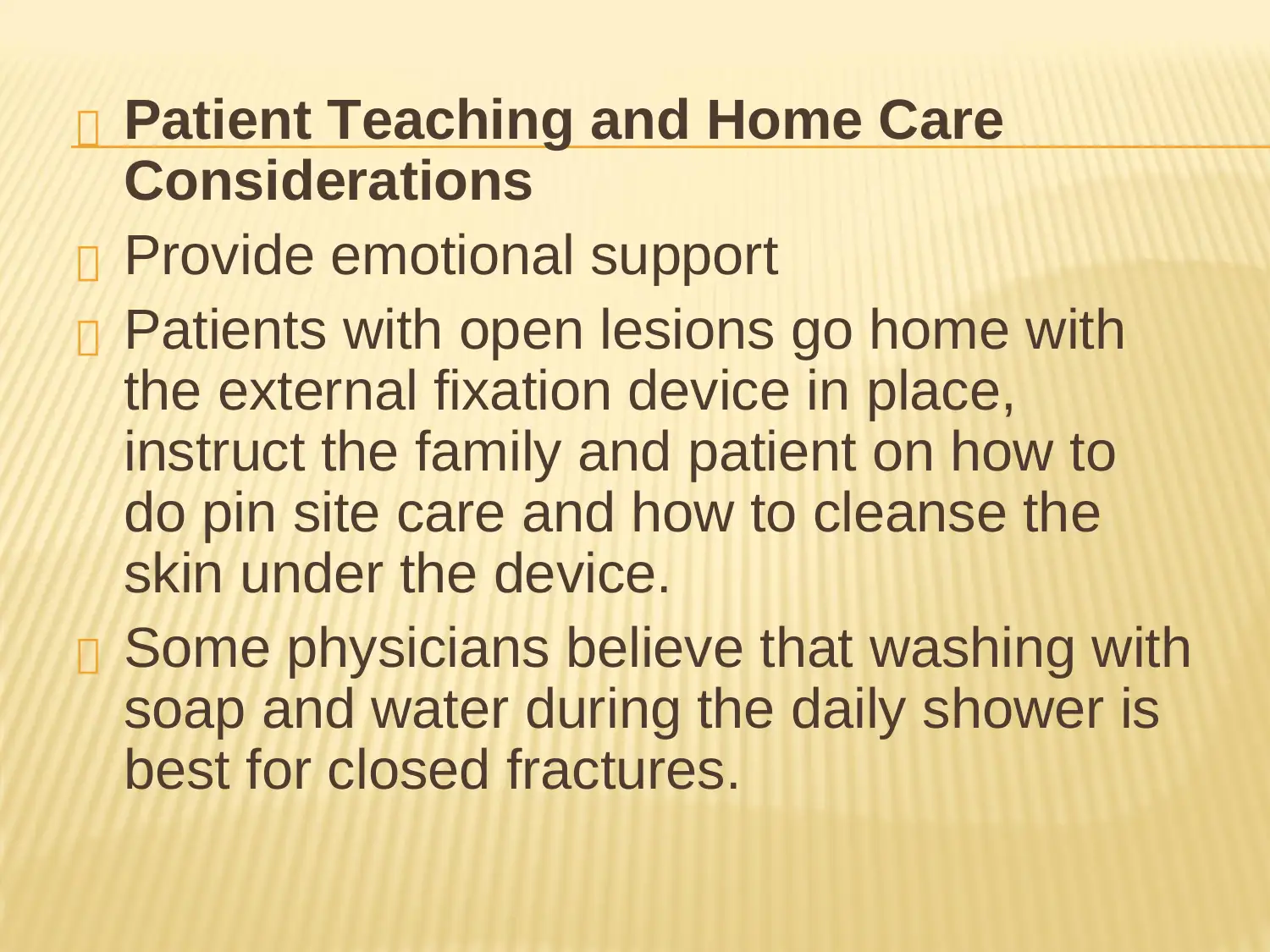
Patient Teaching and Home Care
Considerations
Provide emotional support
Patients with open lesions go home with
the external fixation device in place,
instruct the family and patient on how to
do pin site care and how to cleanse the
skin under the device.
Some physicians believe that washing with
soap and water during the daily shower is
best for closed fractures.
Considerations
Provide emotional support
Patients with open lesions go home with
the external fixation device in place,
instruct the family and patient on how to
do pin site care and how to cleanse the
skin under the device.
Some physicians believe that washing with
soap and water during the daily shower is
best for closed fractures.
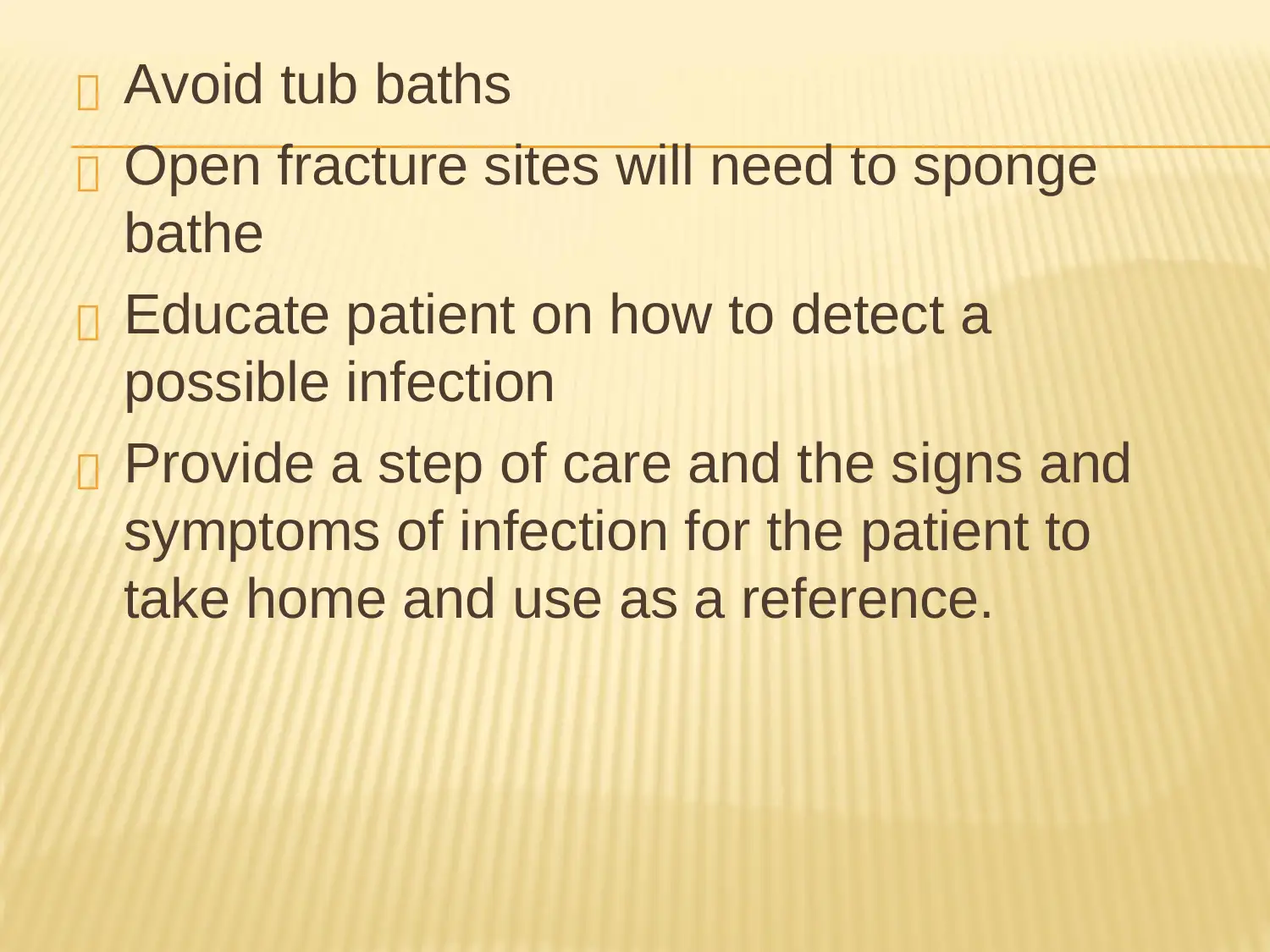
Avoid tub baths
Open fracture sites will need to sponge
bathe
Educate patient on how to detect a
possible infection
Provide a step of care and the signs and
symptoms of infection for the patient to
take home and use as a reference.
Open fracture sites will need to sponge
bathe
Educate patient on how to detect a
possible infection
Provide a step of care and the signs and
symptoms of infection for the patient to
take home and use as a reference.
Paraphrase This Document
Need a fresh take? Get an instant paraphrase of this document with our AI Paraphraser
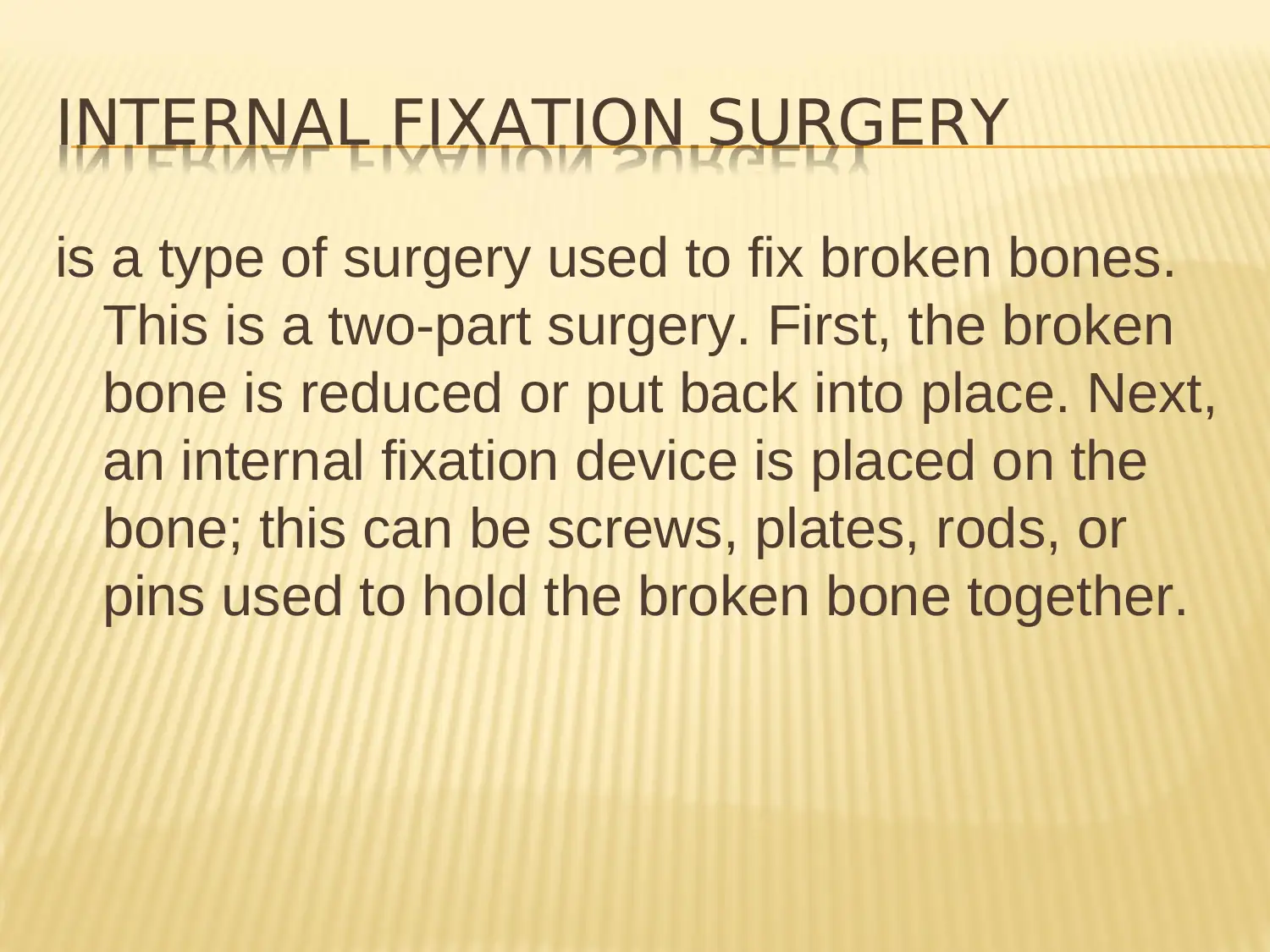
INTERNAL FIXATION SURGERY
is a type of surgery used to fix broken bones.
This is a two-part surgery. First, the broken
bone is reduced or put back into place. Next,
an internal fixation device is placed on the
bone; this can be screws, plates, rods, or
pins used to hold the broken bone together.
is a type of surgery used to fix broken bones.
This is a two-part surgery. First, the broken
bone is reduced or put back into place. Next,
an internal fixation device is placed on the
bone; this can be screws, plates, rods, or
pins used to hold the broken bone together.
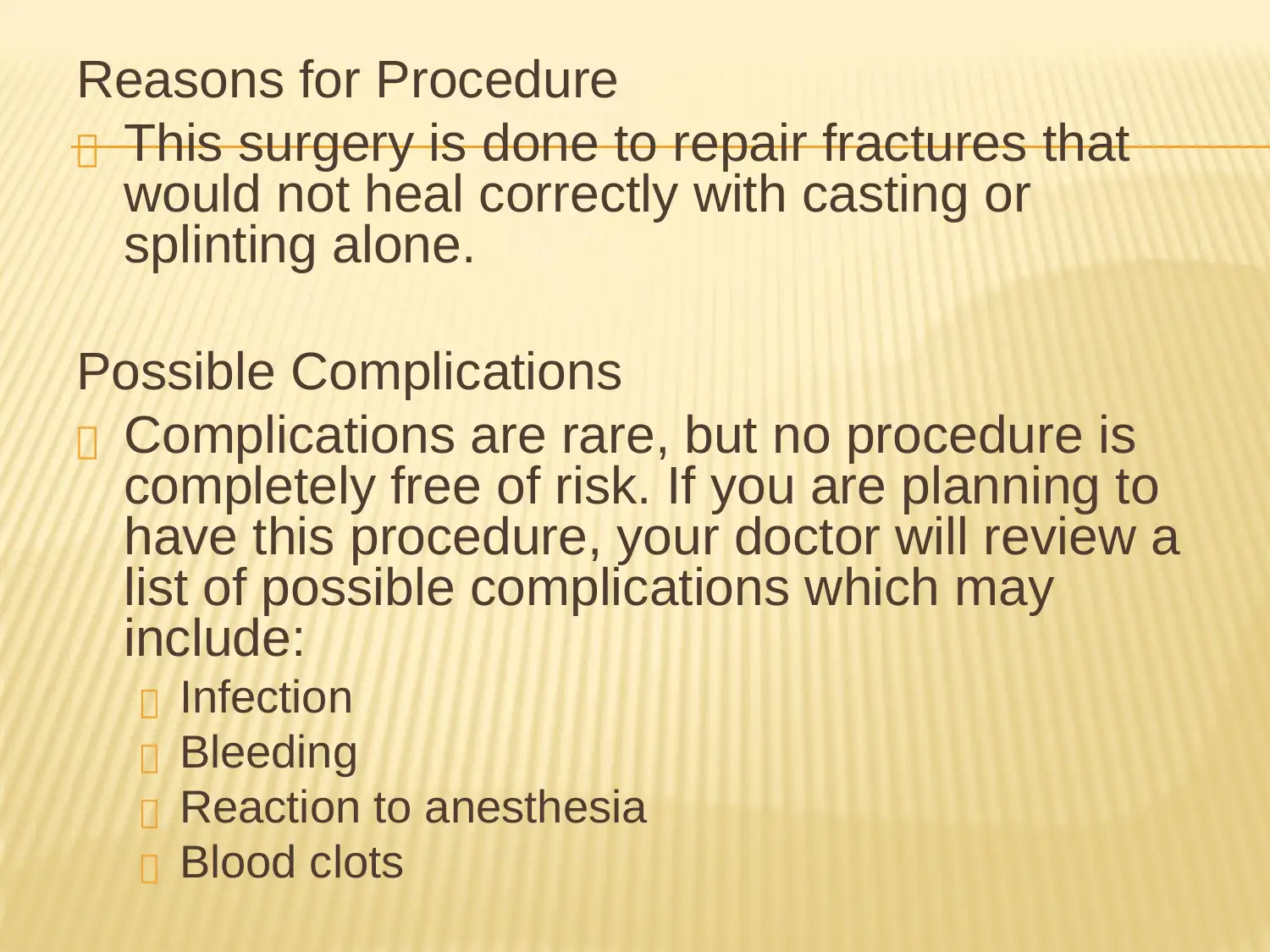
Reasons for Procedure
This surgery is done to repair fractures that
would not heal correctly with casting or
splinting alone.
Possible Complications
Complications are rare, but no procedure is
completely free of risk. If you are planning to
have this procedure, your doctor will review a
list of possible complications which may
include:
Infection
Bleeding
Reaction to anesthesia
Blood clots
This surgery is done to repair fractures that
would not heal correctly with casting or
splinting alone.
Possible Complications
Complications are rare, but no procedure is
completely free of risk. If you are planning to
have this procedure, your doctor will review a
list of possible complications which may
include:
Infection
Bleeding
Reaction to anesthesia
Blood clots
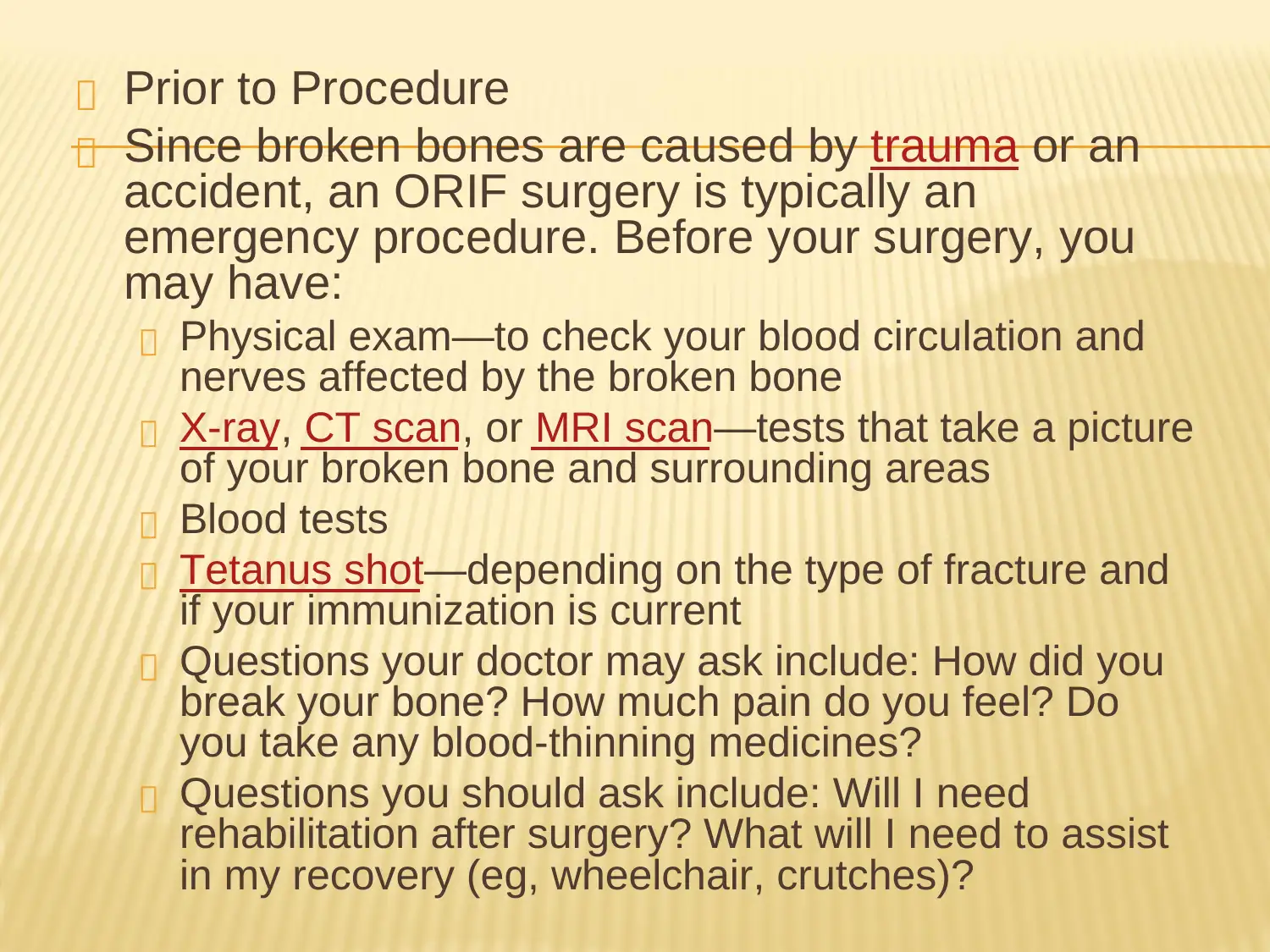
Prior to Procedure
Since broken bones are caused by trauma or an
accident, an ORIF surgery is typically an
emergency procedure. Before your surgery, you
may have:
Physical exam—to check your blood circulation and
nerves affected by the broken bone
X-ray, CT scan, or MRI scan—tests that take a picture
of your broken bone and surrounding areas
Blood tests
Tetanus shot—depending on the type of fracture and
if your immunization is current
Questions your doctor may ask include: How did you
break your bone? How much pain do you feel? Do
you take any blood-thinning medicines?
Questions you should ask include: Will I need
rehabilitation after surgery? What will I need to assist
in my recovery (eg, wheelchair, crutches)?
Since broken bones are caused by trauma or an
accident, an ORIF surgery is typically an
emergency procedure. Before your surgery, you
may have:
Physical exam—to check your blood circulation and
nerves affected by the broken bone
X-ray, CT scan, or MRI scan—tests that take a picture
of your broken bone and surrounding areas
Blood tests
Tetanus shot—depending on the type of fracture and
if your immunization is current
Questions your doctor may ask include: How did you
break your bone? How much pain do you feel? Do
you take any blood-thinning medicines?
Questions you should ask include: Will I need
rehabilitation after surgery? What will I need to assist
in my recovery (eg, wheelchair, crutches)?
Secure Best Marks with AI Grader
Need help grading? Try our AI Grader for instant feedback on your assignments.
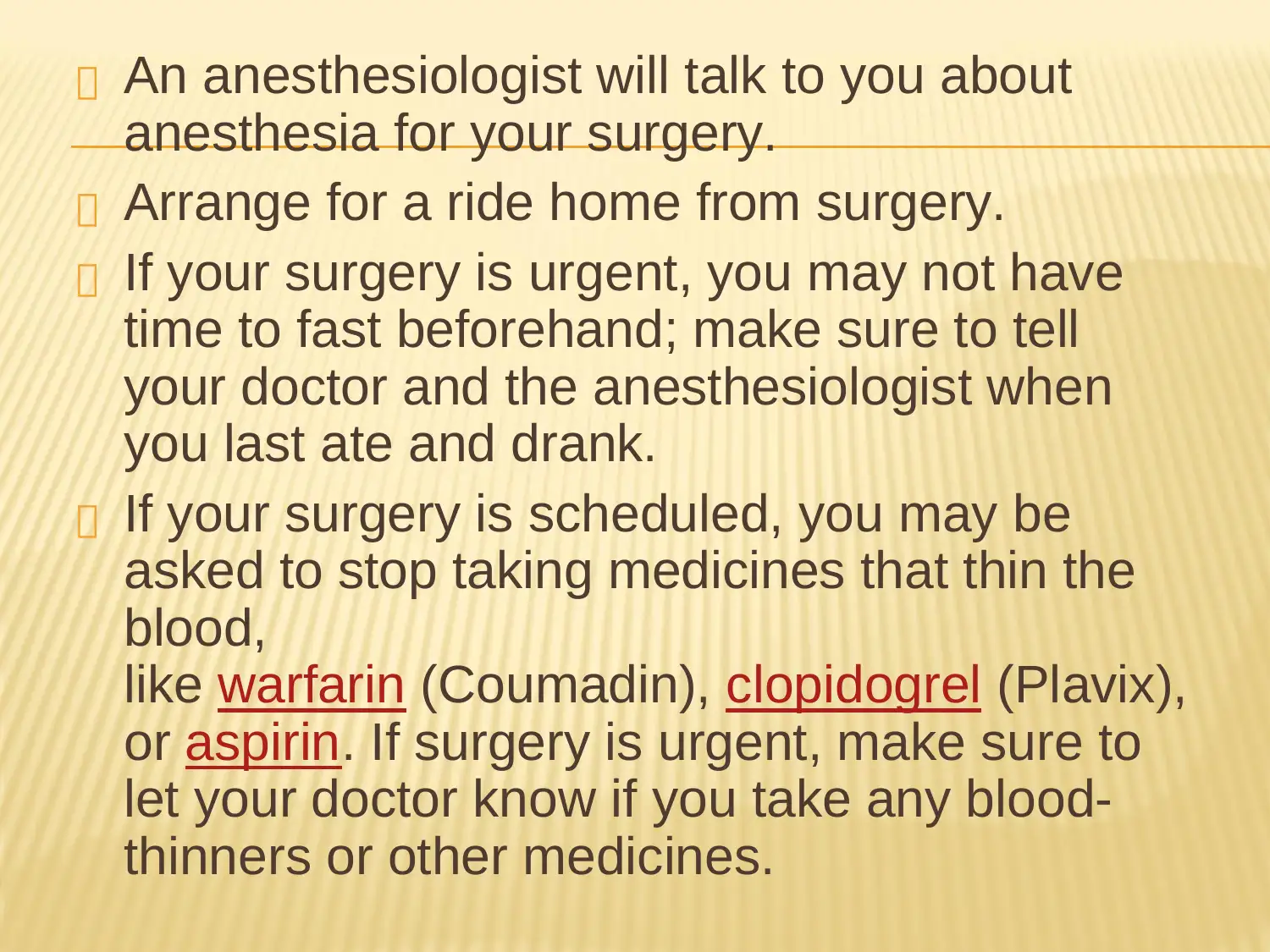
An anesthesiologist will talk to you about
anesthesia for your surgery.
Arrange for a ride home from surgery.
If your surgery is urgent, you may not have
time to fast beforehand; make sure to tell
your doctor and the anesthesiologist when
you last ate and drank.
If your surgery is scheduled, you may be
asked to stop taking medicines that thin the
blood,
like warfarin (Coumadin), clopidogrel (Plavix),
or aspirin. If surgery is urgent, make sure to
let your doctor know if you take any blood-
thinners or other medicines.
anesthesia for your surgery.
Arrange for a ride home from surgery.
If your surgery is urgent, you may not have
time to fast beforehand; make sure to tell
your doctor and the anesthesiologist when
you last ate and drank.
If your surgery is scheduled, you may be
asked to stop taking medicines that thin the
blood,
like warfarin (Coumadin), clopidogrel (Plavix),
or aspirin. If surgery is urgent, make sure to
let your doctor know if you take any blood-
thinners or other medicines.
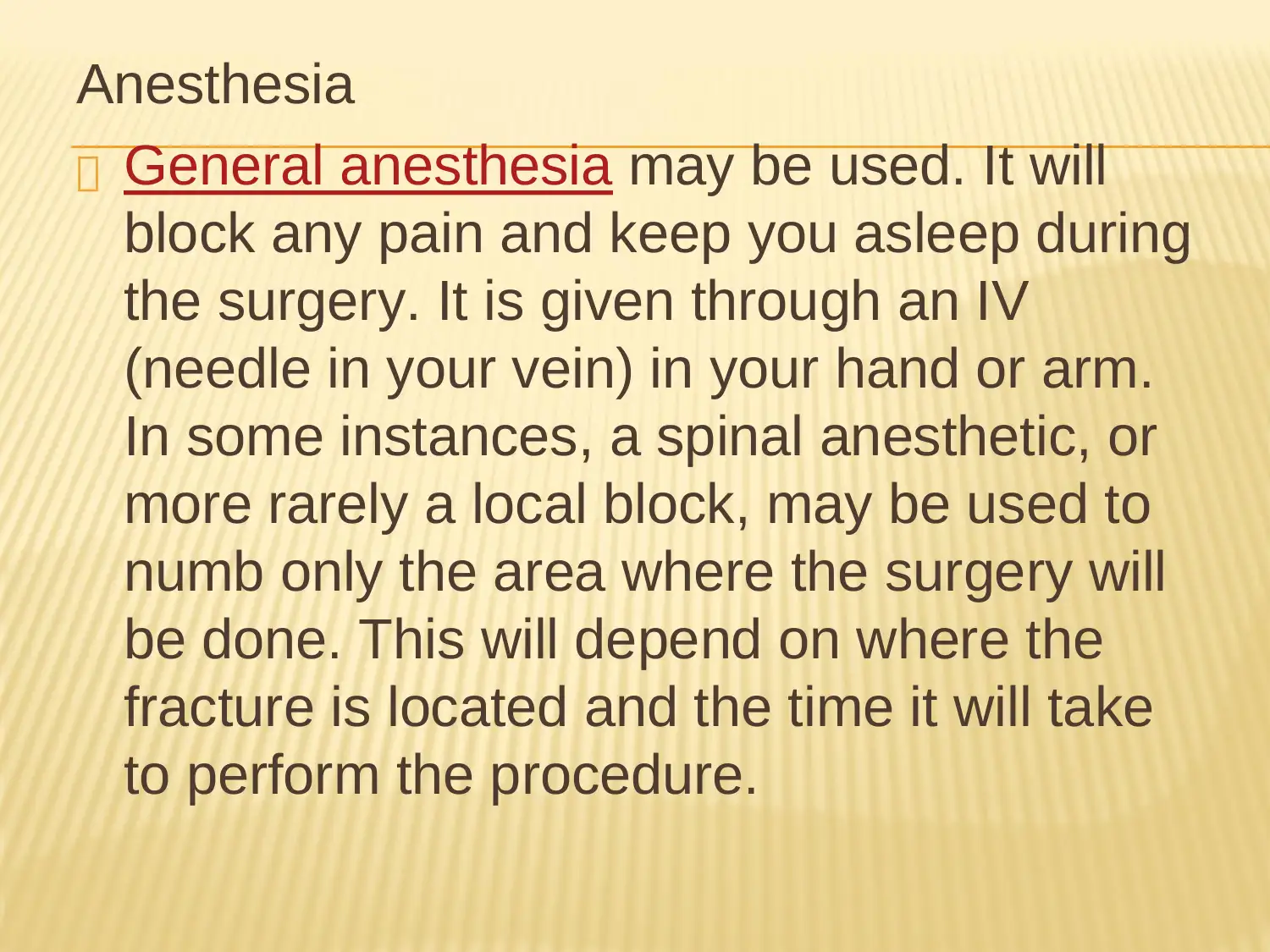
Anesthesia
General anesthesia may be used. It will
block any pain and keep you asleep during
the surgery. It is given through an IV
(needle in your vein) in your hand or arm.
In some instances, a spinal anesthetic, or
more rarely a local block, may be used to
numb only the area where the surgery will
be done. This will depend on where the
fracture is located and the time it will take
to perform the procedure.
General anesthesia may be used. It will
block any pain and keep you asleep during
the surgery. It is given through an IV
(needle in your vein) in your hand or arm.
In some instances, a spinal anesthetic, or
more rarely a local block, may be used to
numb only the area where the surgery will
be done. This will depend on where the
fracture is located and the time it will take
to perform the procedure.
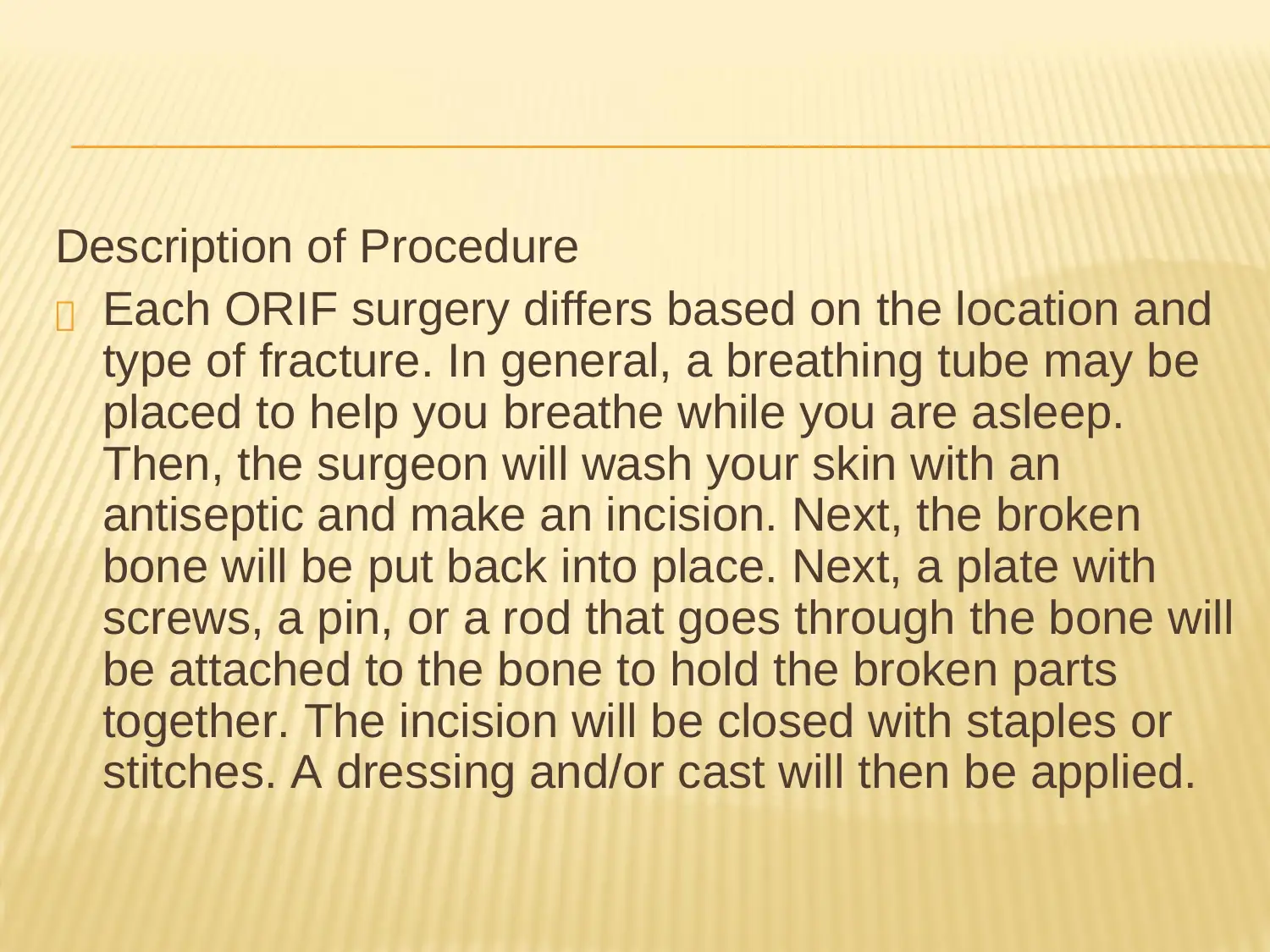
Description of Procedure
Each ORIF surgery differs based on the location and
type of fracture. In general, a breathing tube may be
placed to help you breathe while you are asleep.
Then, the surgeon will wash your skin with an
antiseptic and make an incision. Next, the broken
bone will be put back into place. Next, a plate with
screws, a pin, or a rod that goes through the bone will
be attached to the bone to hold the broken parts
together. The incision will be closed with staples or
stitches. A dressing and/or cast will then be applied.
Each ORIF surgery differs based on the location and
type of fracture. In general, a breathing tube may be
placed to help you breathe while you are asleep.
Then, the surgeon will wash your skin with an
antiseptic and make an incision. Next, the broken
bone will be put back into place. Next, a plate with
screws, a pin, or a rod that goes through the bone will
be attached to the bone to hold the broken parts
together. The incision will be closed with staples or
stitches. A dressing and/or cast will then be applied.
Paraphrase This Document
Need a fresh take? Get an instant paraphrase of this document with our AI Paraphraser
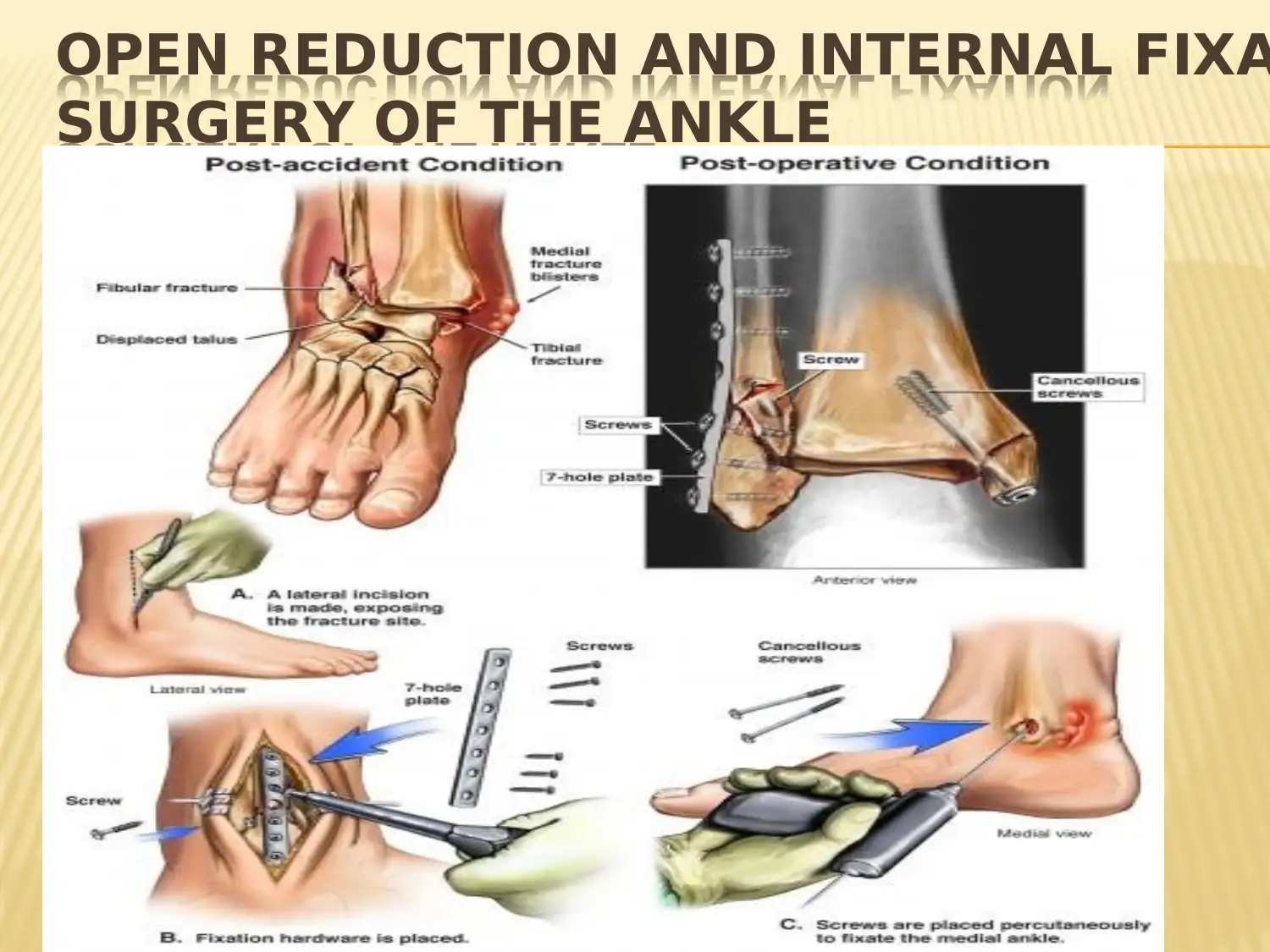
OPEN REDUCTION AND INTERNAL FIXA
SURGERY OF THE ANKLE
SURGERY OF THE ANKLE
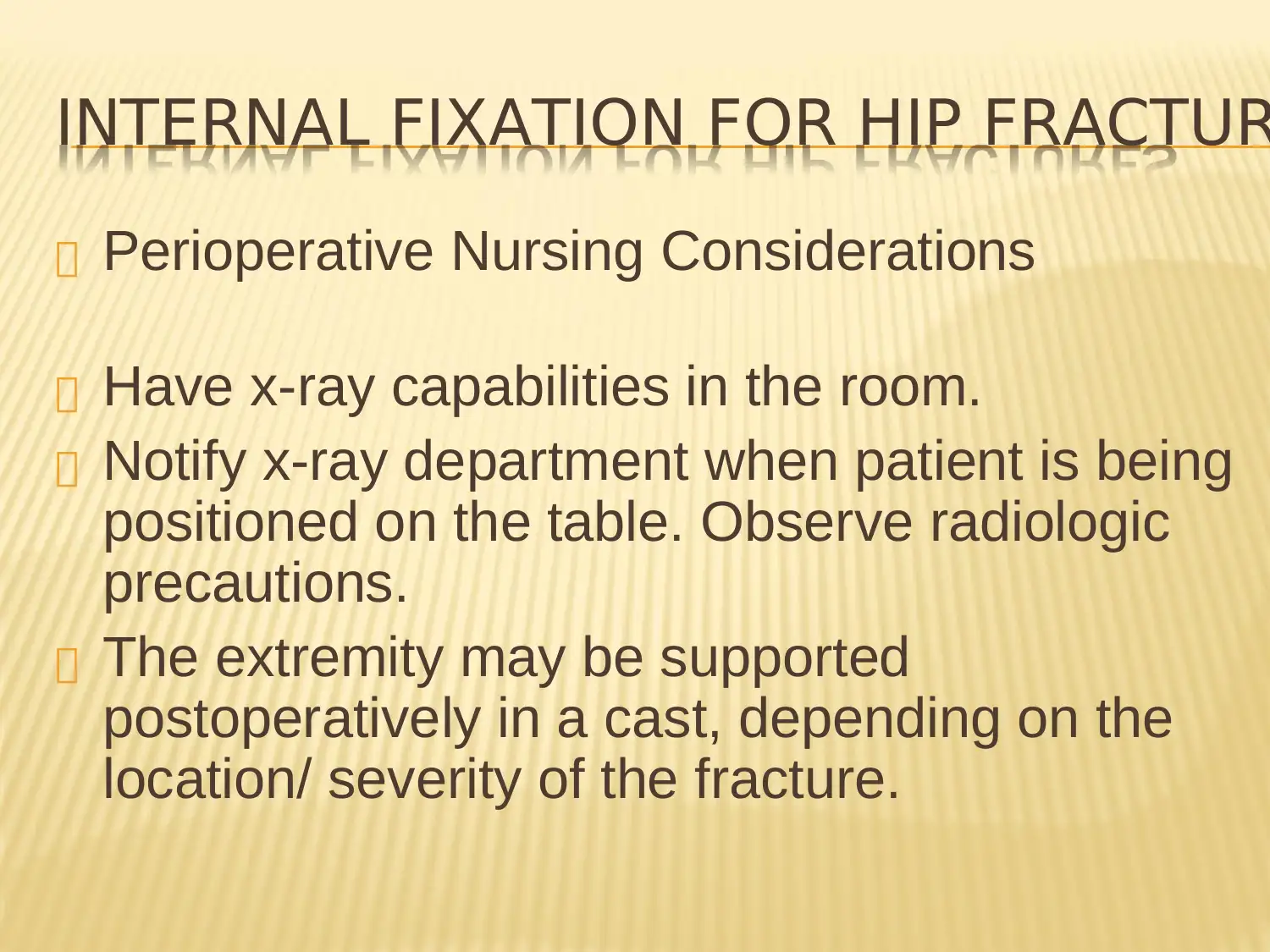
INTERNAL FIXATION FOR HIP FRACTUR
Perioperative Nursing Considerations
Have x-ray capabilities in the room.
Notify x-ray department when patient is being
positioned on the table. Observe radiologic
precautions.
The extremity may be supported
postoperatively in a cast, depending on the
location/ severity of the fracture.
Perioperative Nursing Considerations
Have x-ray capabilities in the room.
Notify x-ray department when patient is being
positioned on the table. Observe radiologic
precautions.
The extremity may be supported
postoperatively in a cast, depending on the
location/ severity of the fracture.
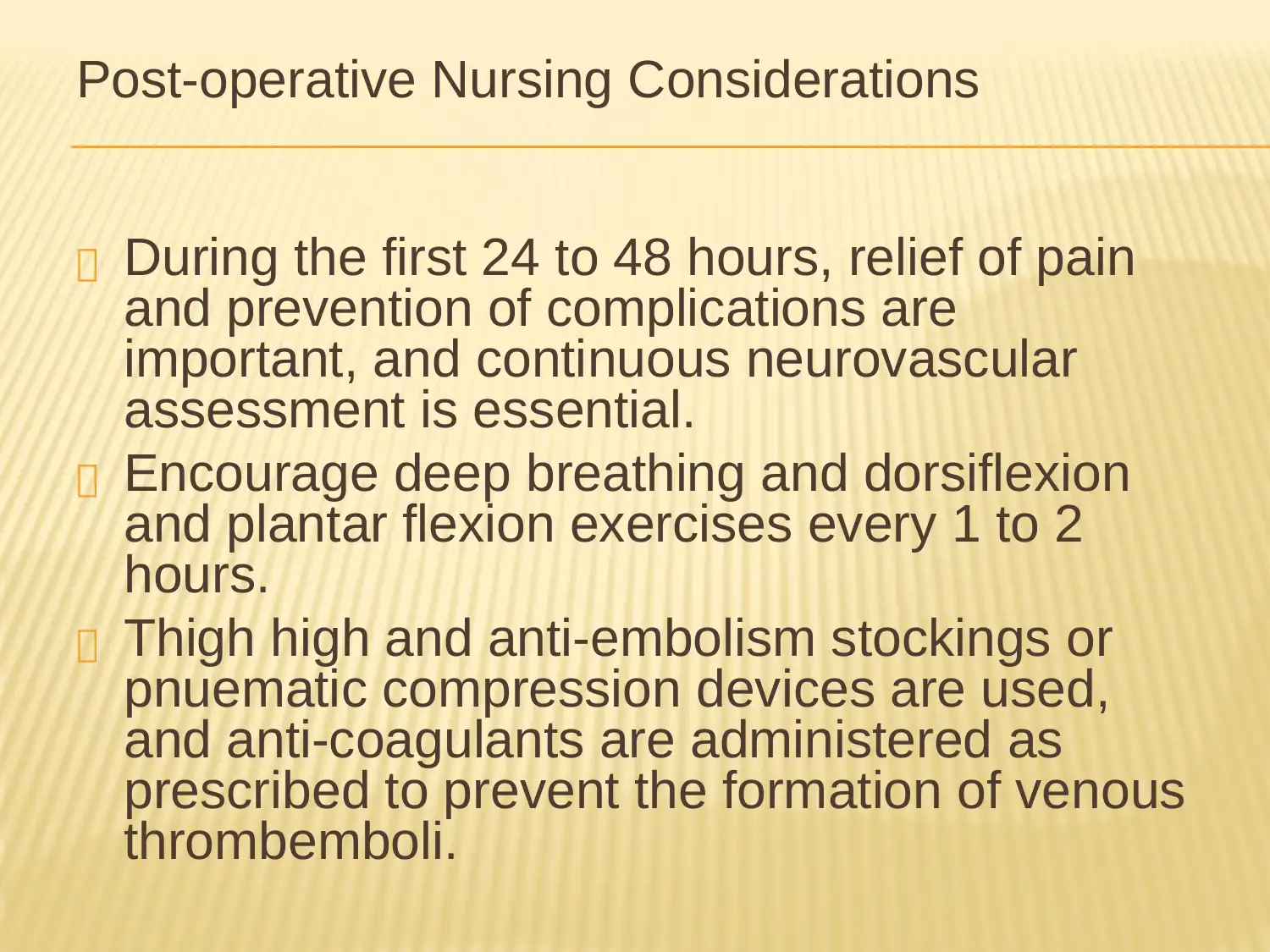
Post-operative Nursing Considerations
During the first 24 to 48 hours, relief of pain
and prevention of complications are
important, and continuous neurovascular
assessment is essential.
Encourage deep breathing and dorsiflexion
and plantar flexion exercises every 1 to 2
hours.
Thigh high and anti-embolism stockings or
pnuematic compression devices are used,
and anti-coagulants are administered as
prescribed to prevent the formation of venous
thrombemboli.
During the first 24 to 48 hours, relief of pain
and prevention of complications are
important, and continuous neurovascular
assessment is essential.
Encourage deep breathing and dorsiflexion
and plantar flexion exercises every 1 to 2
hours.
Thigh high and anti-embolism stockings or
pnuematic compression devices are used,
and anti-coagulants are administered as
prescribed to prevent the formation of venous
thrombemboli.
Secure Best Marks with AI Grader
Need help grading? Try our AI Grader for instant feedback on your assignments.
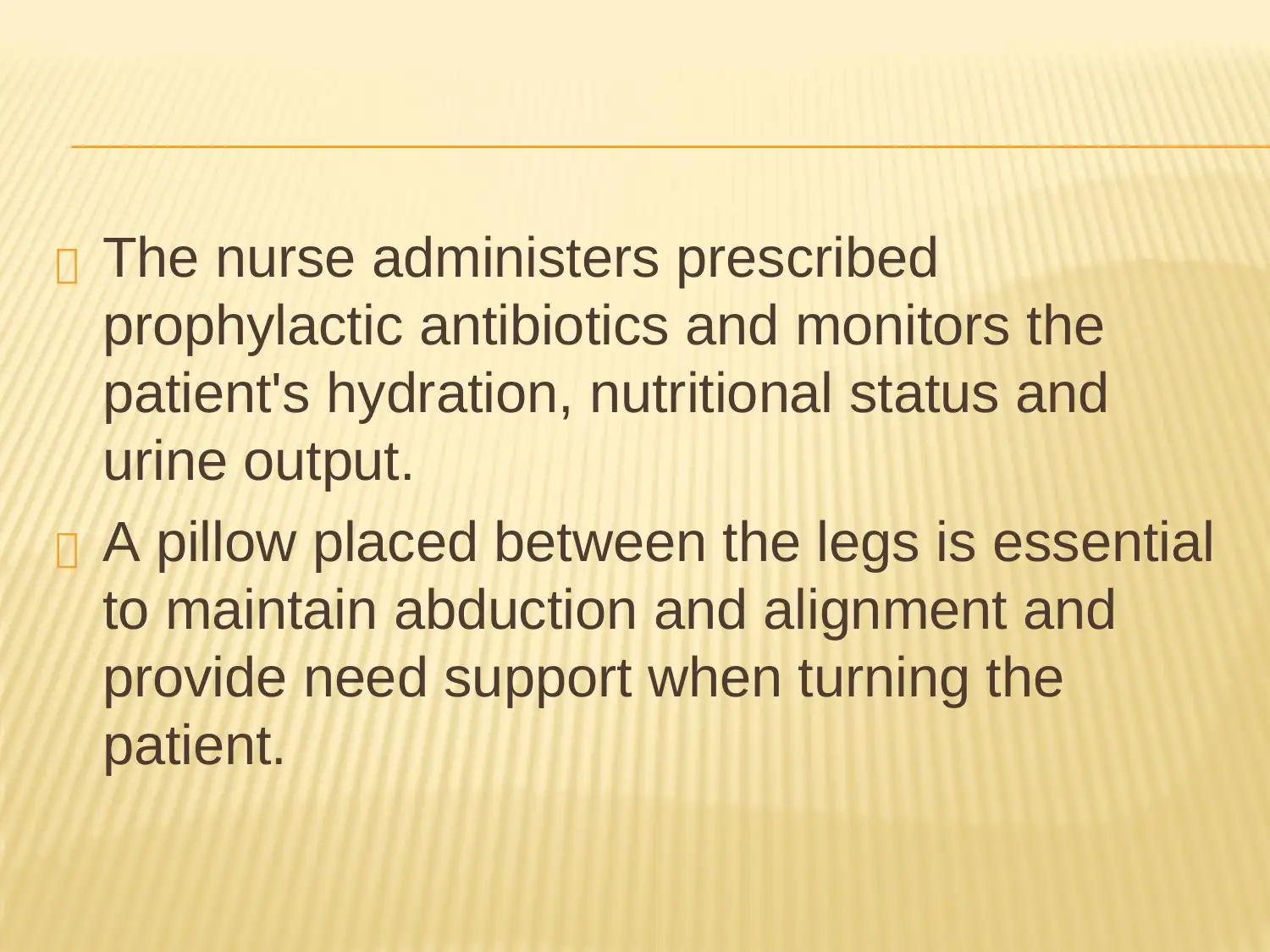
The nurse administers prescribed
prophylactic antibiotics and monitors the
patient's hydration, nutritional status and
urine output.
A pillow placed between the legs is essential
to maintain abduction and alignment and
provide need support when turning the
patient.
prophylactic antibiotics and monitors the
patient's hydration, nutritional status and
urine output.
A pillow placed between the legs is essential
to maintain abduction and alignment and
provide need support when turning the
patient.
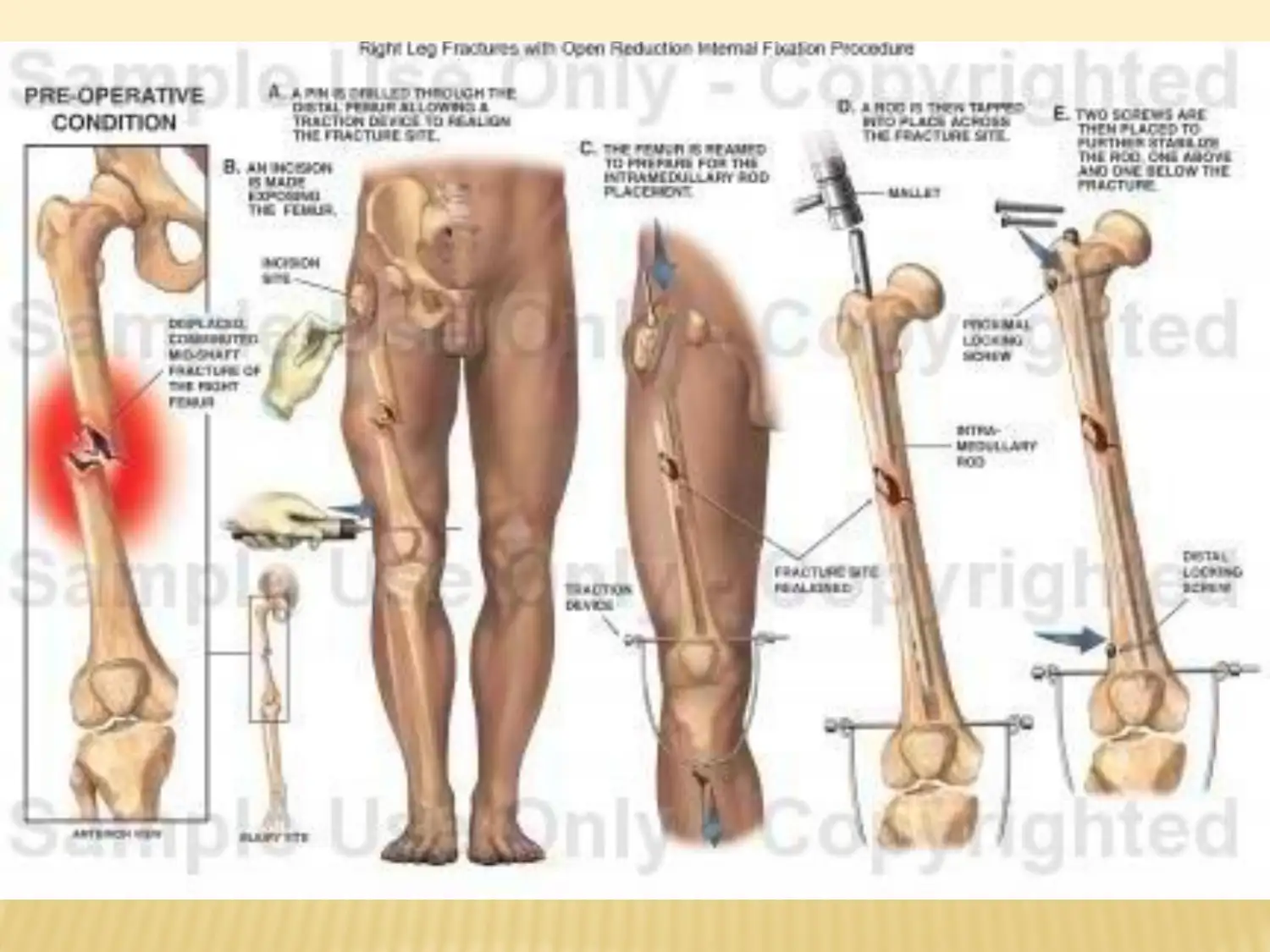
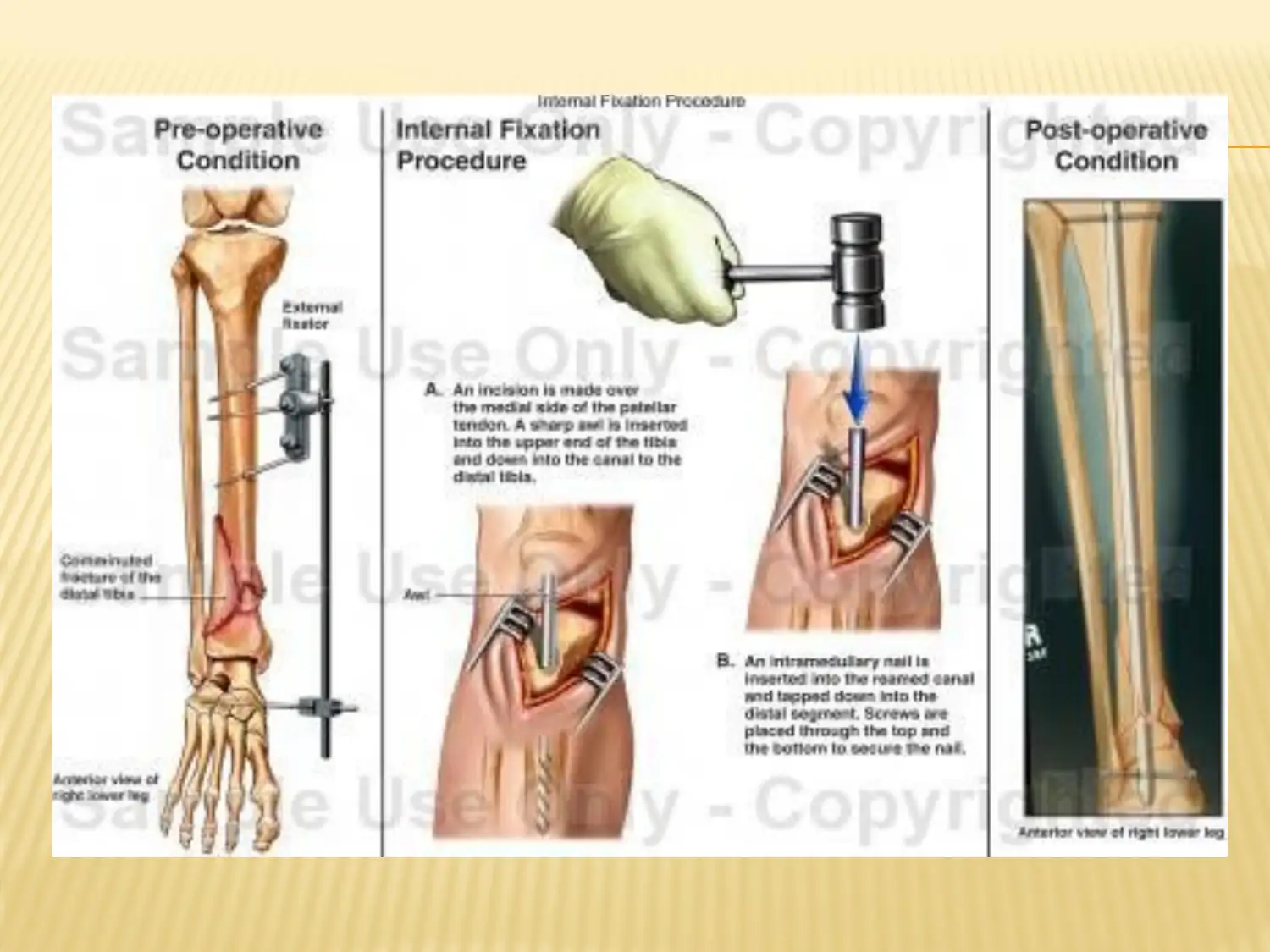
Paraphrase This Document
Need a fresh take? Get an instant paraphrase of this document with our AI Paraphraser
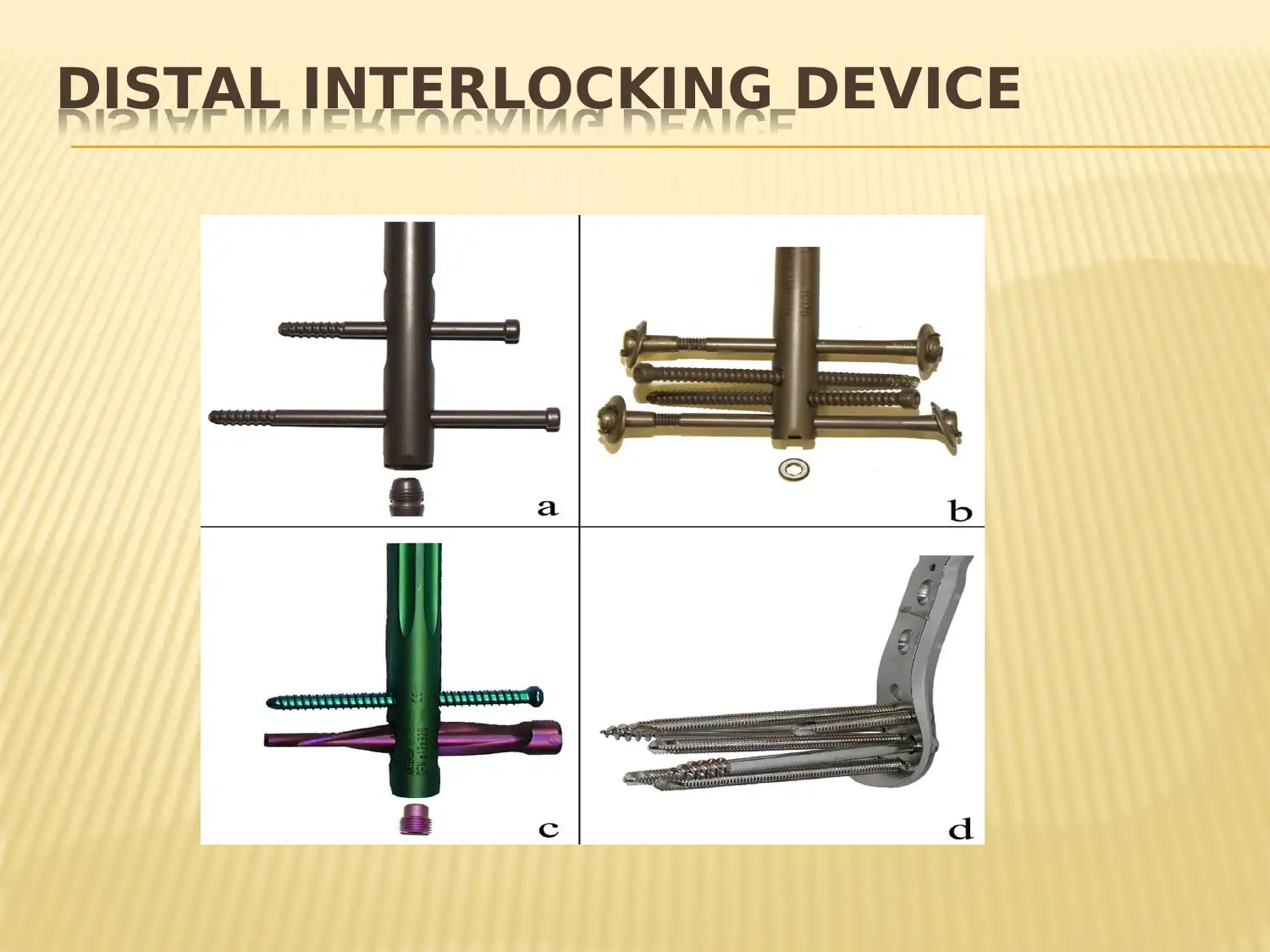
DISTAL INTERLOCKING DEVICE
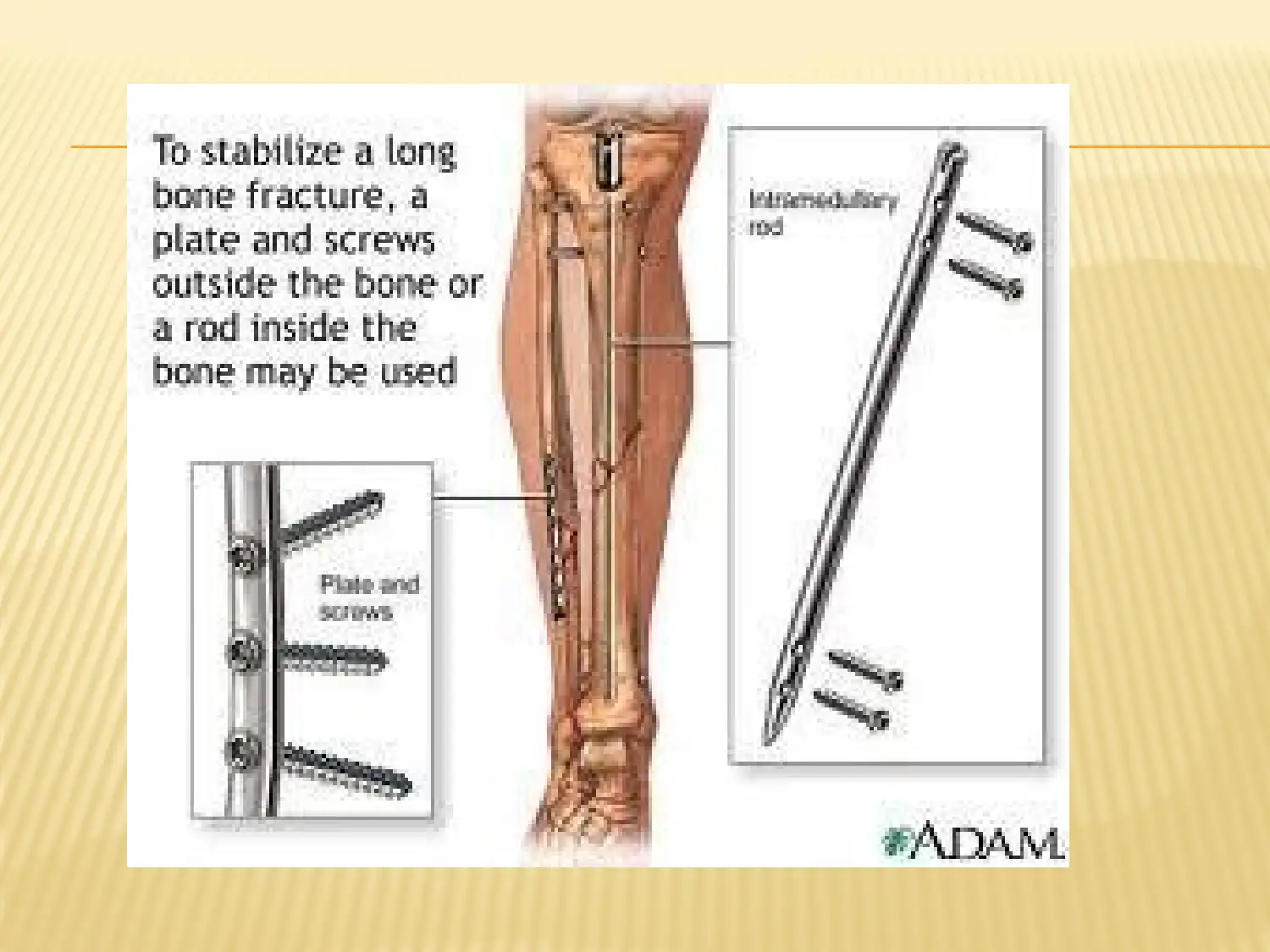
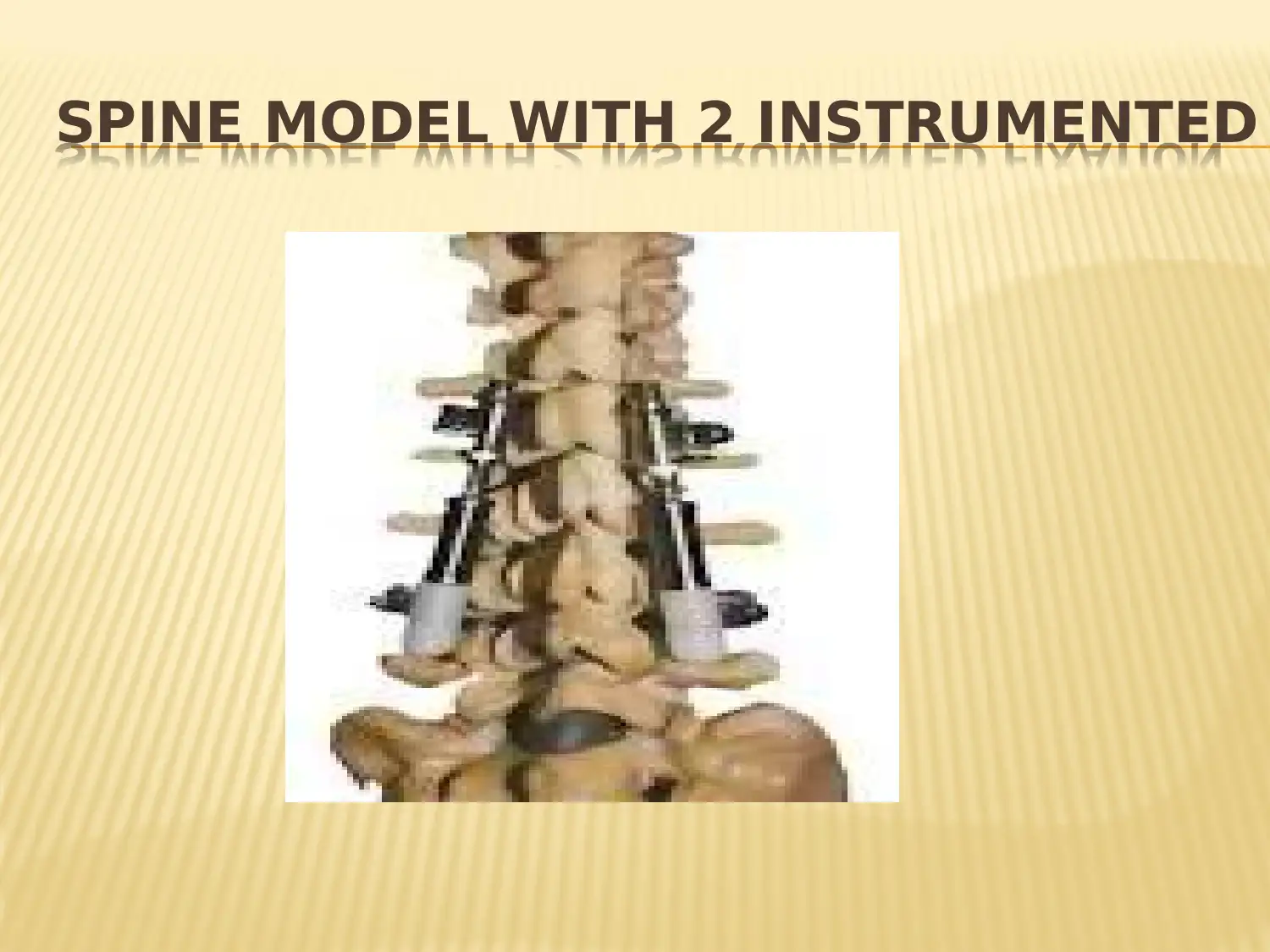
SPINE MODEL WITH 2 INSTRUMENTED
Secure Best Marks with AI Grader
Need help grading? Try our AI Grader for instant feedback on your assignments.
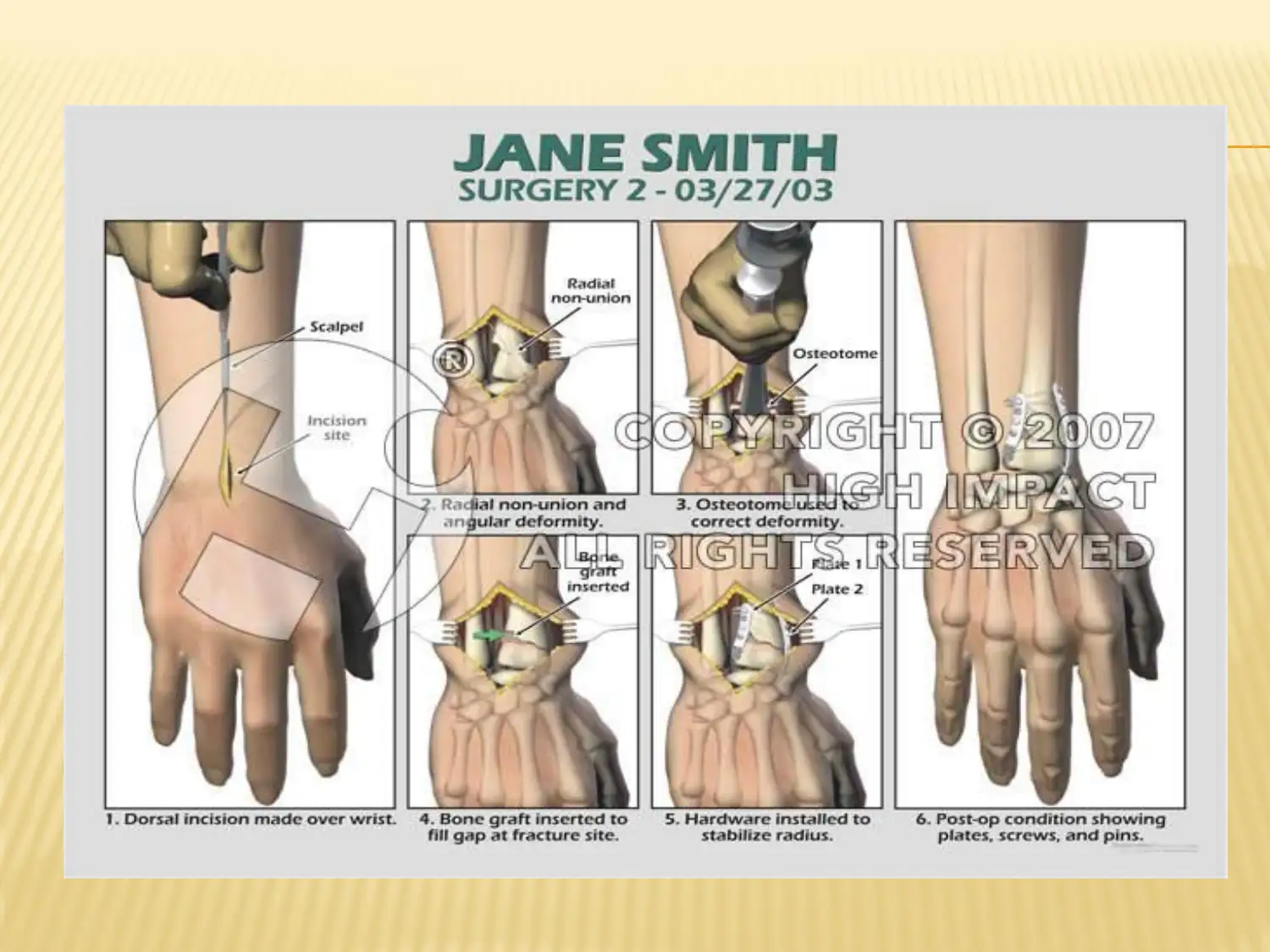
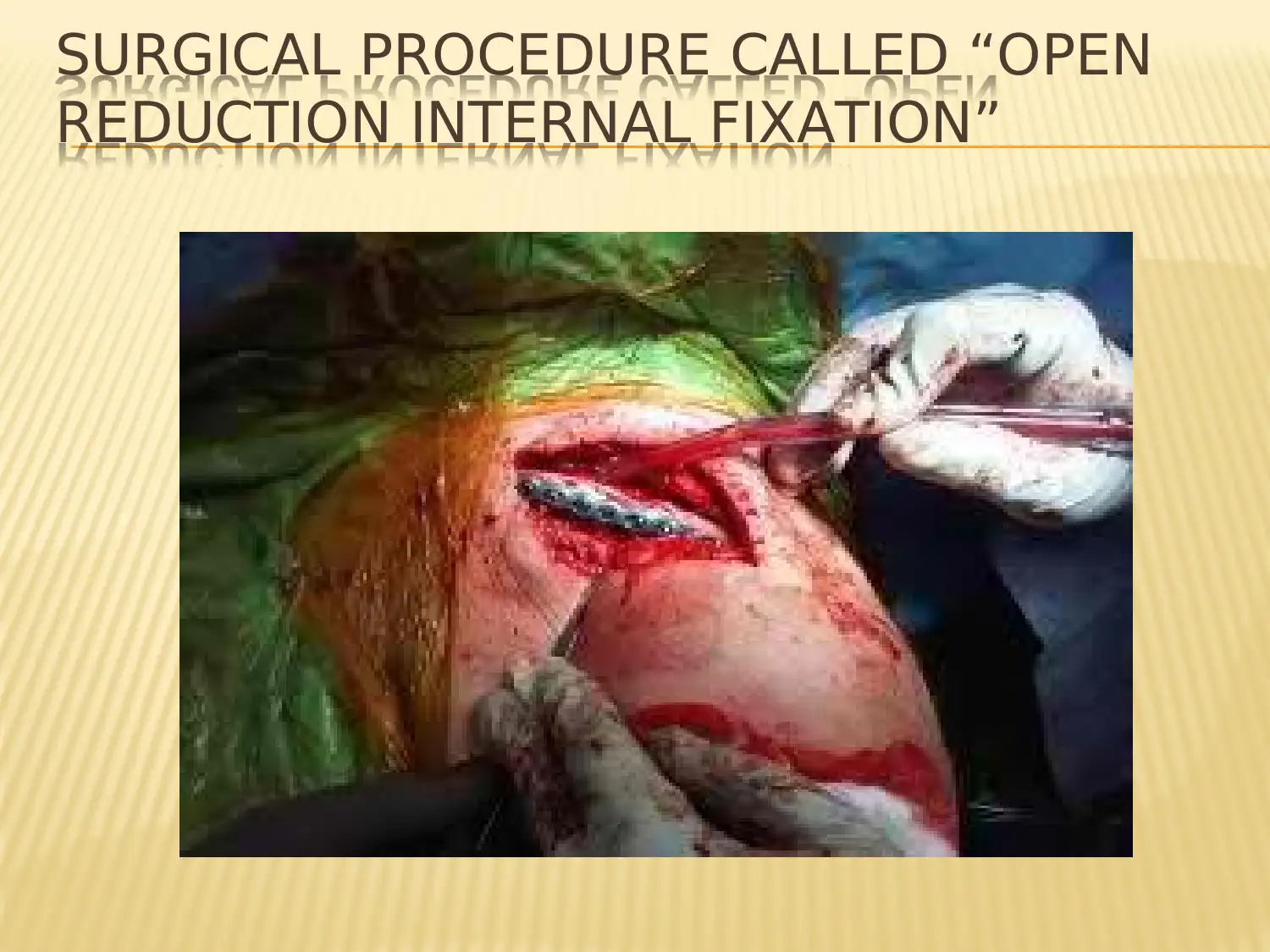
SURGICAL PROCEDURE CALLED “OPEN
REDUCTION INTERNAL FIXATION”
REDUCTION INTERNAL FIXATION”
1 out of 24
Related Documents
Your All-in-One AI-Powered Toolkit for Academic Success.
+13062052269
info@desklib.com
Available 24*7 on WhatsApp / Email
![[object Object]](/_next/static/media/star-bottom.7253800d.svg)
Unlock your academic potential
© 2024 | Zucol Services PVT LTD | All rights reserved.




